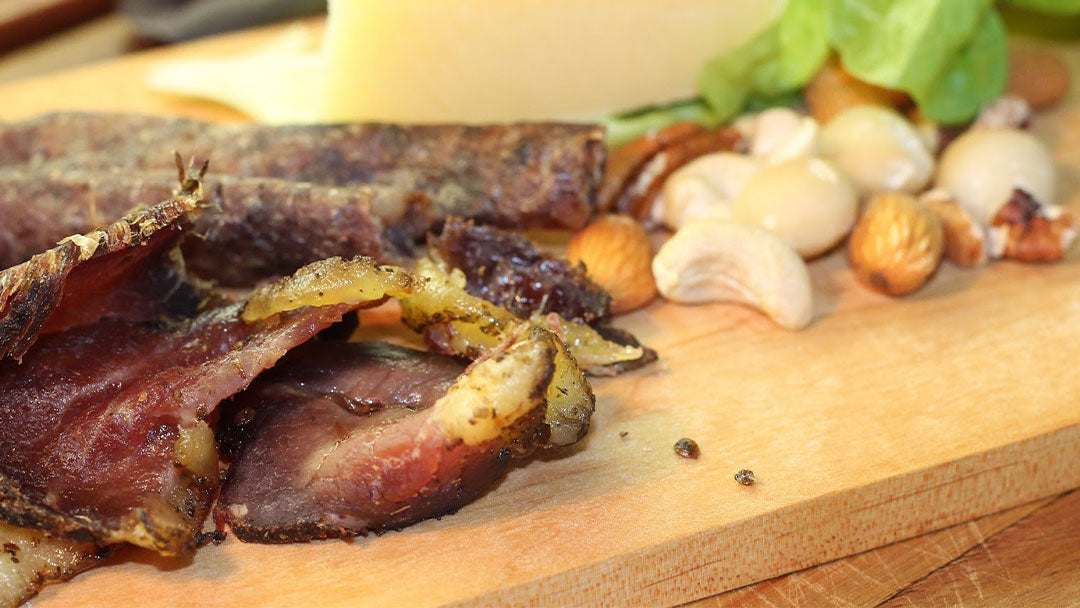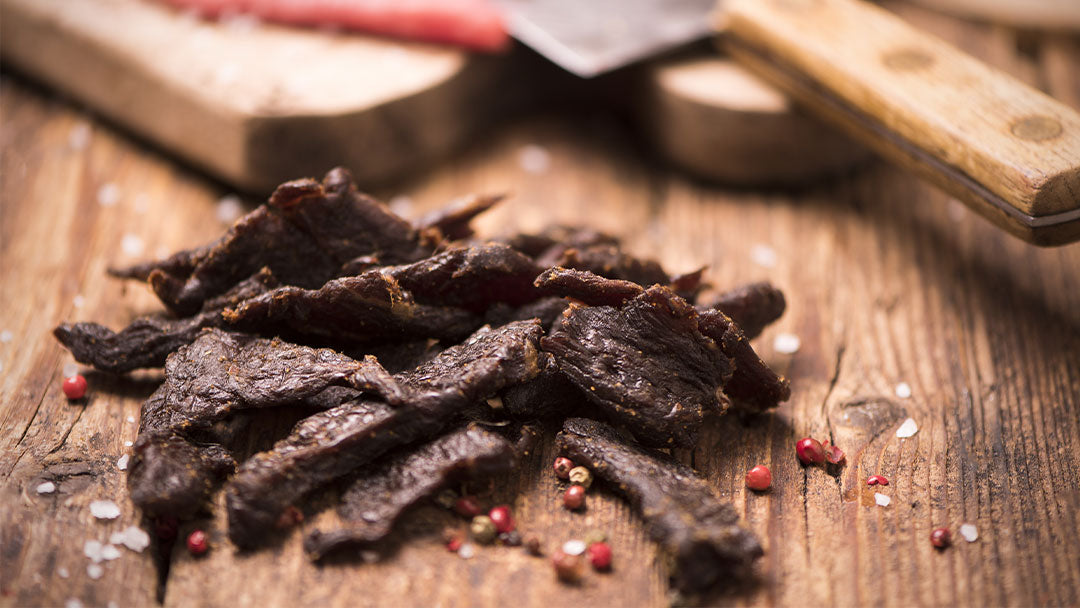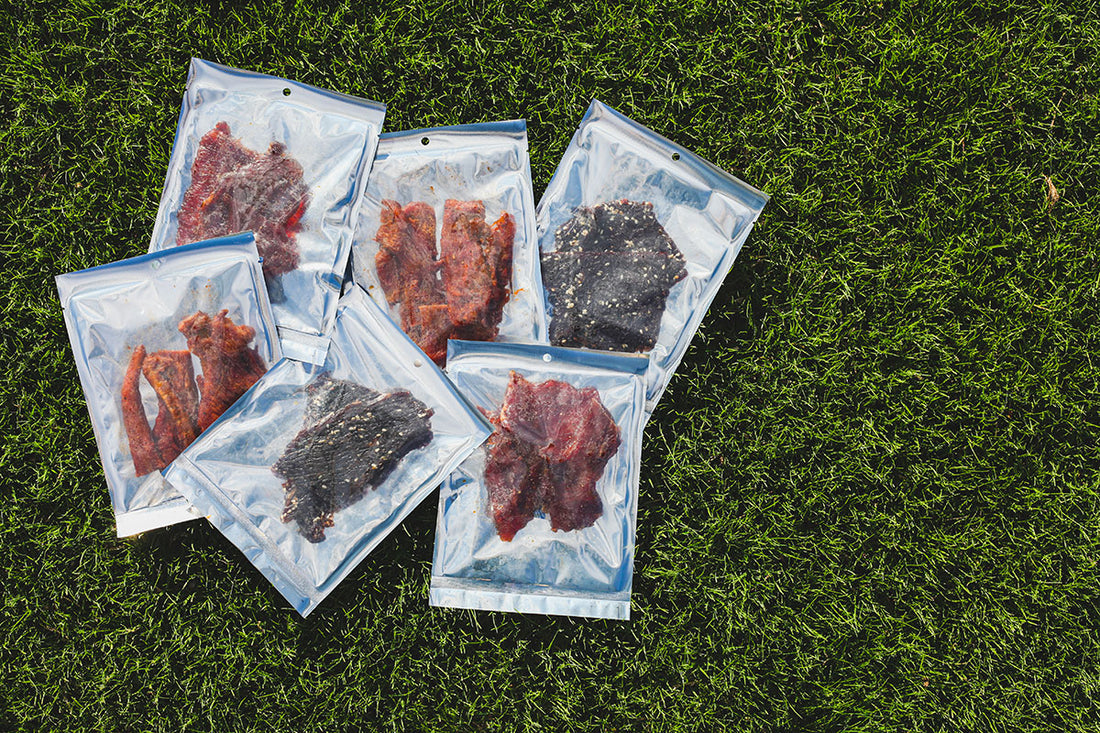
Introduction
Definition Of Beef Jerky And Its Popularity As A Snack
Beef jerky is a dried meat snack that has gained immense popularity due to its savory flavor and convenience. It is typically made by marinating strips of beef in a mixture of spices and seasonings and then drying them to remove moisture. The result is a chewy and flavorful snack that can be enjoyed on its own or as a protein boost in various dishes.
Importance Of Maximizing Jerky Shelf Life For Optimal Enjoyment
One key aspect of enjoying beef jerky is understanding its shelf life and implementing proper storage practices. By maximizing the shelf life of beef jerky, you can ensure that it remains fresh and flavorful for a longer time span, allowing you to savor its taste at your convenience.
How Long Does Beef Jerky Last?
The shelf life of beef jerky can vary depending on whether it is homemade or store-bought. Generally, commercial beef jerky is best enjoyed within one year of its production date. On the other hand, homemade beef jerky typically lasts for about two to three months.
To ensure the longevity of your beef jerky, it is crucial to store it properly. It should be kept in an airtight container or resealable bag to prevent moisture and air exposure. Additionally, it is recommended to store beef jerky in a cool, dry place away from direct sunlight, as exposure to heat and light can accelerate spoilage.
Storing Tips For Beef Jerky
Here are some key tips for storing beef jerky and maximizing its shelf life:
- Keep it airtight: To prevent moisture from seeping in, store beef jerky in an airtight container or resealable bag. This will help maintain its texture and flavor.
- Store in a cool, dry place: Temperature and humidity can affect the quality and shelf life of beef jerky. Store it in a cool, dry place, such as a pantry or cupboard, away from heat sources and direct sunlight.
- Avoid exposure to air: The less air exposure beef jerky has, the longer it will stay fresh. If possible, use a vacuum-sealed bag or remove as much air as possible before sealing the container.
- Check for signs of spoilage: Before consuming beef jerky, inspect it for any signs of mold, off-putting smell, or texture changes. If you notice any of these signs, it is best to discard the jerky to avoid any potential health risks.
By following these simple storing tips, you can extend the shelf life of your beef jerky and enjoy its delicious flavor for a longer period. Whether you prefer homemade or store-bought beef jerky, proper storage practices play a vital role in maintaining its quality and taste.
Factors Affecting Beef Jerky Shelf Life
Role Of Moisture In The Growth Of Mold
The presence of moisture is one of the primary factors that can accelerate the spoilage of beef jerky. When exposed to moisture, beef jerky becomes a suitable environment for the growth of mold and bacteria. This can lead to an unpleasant taste and potential health risks. To prevent this, it is essential to remove all traces of moisture from the jerky before storing it.
The Impact Of Temperature And Storage Conditions On Jerky Freshness
Temperature and storage conditions have a significant impact on the freshness and shelf life of beef jerky. Exposure to heat, moisture, and light can lead to the deterioration of the jerky’s quality. Storing beef jerky in a cool, dry place, such as a pantry or cupboard, away from direct sunlight and heat sources, is crucial to maintaining its freshness for a longer period. Additionally, it is best to keep the jerky in an airtight container or resealable bag to prevent air exposure.
By considering these factors and implementing proper storage practices, you can maximize the shelf life of your beef jerky and ensure optimal freshness. Whether you prefer store-bought or homemade jerky, taking care of it by storing it correctly will allow you to enjoy its savory flavor whenever cravings strike.
Proper Storage Techniques For Beef Jerky
When it comes to maintaining the freshness and quality of beef jerky, proper storage is crucial. Here are some recommendations for storing both opened and unopened beef jerky:
Recommendations For Storing Opened Beef Jerky
- After opening the packaging, tightly reseal the jerky in its original packaging or transfer it to an airtight container or resealable bag.
- Ensure that no moisture gets in contact with the jerky as it can lead to mold growth. Use desiccant packs to absorb any excess moisture.
- Store the opened jerky in a cool and dry place, away from direct sunlight, heat sources, and humidity.
- If you live in a particularly humid environment, you may want to consider storing the opened jerky in the refrigerator to prolong its shelf life. However, be aware that refrigeration can cause the jerky to become slightly harder.
Guidelines For Storing Unopened Beef Jerky
- Leave the unopened beef jerky in its original packaging until ready to consume.
- Ensure that the packaging is sealed properly to prevent any air or moisture from getting inside.
- Store the unopened jerky in a cool, dry place, away from direct sunlight and heat sources.
- Avoid storing the jerky near strong odors as it can affect the flavor of the product.
By following these storage recommendations, you can extend the shelf life of your beef jerky and maintain its quality for a longer period. Remember to always check the expiration date and discard any jerky that shows signs of spoilage, such as an off smell, unusual texture, or mold growth. Proper storage practices will help you enjoy your beef jerky to the fullest while ensuring food safety.

Shelf Life Of Beef Jerky
How Long Can Beef Jerky Last When Stored Correctly?
Beef jerky can have a long shelf life when stored properly. Its longevity can vary depending on whether it is homemade or store-bought. Here are some key points about the shelf life of beef jerky:
- The shelf life of unopened beef jerky can range from one week to indefinitely, depending on the storage conditions.
- If you store your unopened beef jerky in a dry, cool, and dark place, it can last for at least one year at room temperature or in the fridge.
- When stored unopened in the freezer, beef jerky has the potential to last up to two years.
The Longest Lifespan Of Unopened Beef Jerky And Storage Options For Extended Shelf Life
The longest lifespan of beef jerky is typically for unopened packages. To maximize the shelf life of unopened beef jerky, follow these guidelines:
- Keep the jerky in its original packaging until you are ready to consume it.
- Ensure the packaging is sealed properly to prevent air and moisture from getting inside.
- Store the unopened jerky in a cool, dry place, away from direct sunlight and heat sources.
- Avoid storing the jerky near strong odors as it can affect the flavor of the product.
To extend the shelf life even further:
- Consider refrigerating the opened beef jerky if you live in a humid environment. However, note that refrigeration can make the jerky slightly harder.
- After opening the packaging, tightly reseal the jerky in its original packaging or transfer it to an airtight container or resealable bag.
- Use desiccant packs to absorb any excess moisture and prevent mold growth.
- Store the opened jerky in a cool and dry place, away from direct sunlight, heat sources, and humidity.
By following these storage recommendations, you can extend the shelf life of beef jerky and maintain its quality for a longer period. Always check the expiration date and discard any jerky that shows signs of spoilage. With proper storage practices, you can enjoy your beef jerky and ensure food safety.
Signs Of Spoiled Beef Jerky
Visual Cues Indicating Spoiled Jerky
When inspecting beef jerky for signs of spoilage, visual cues can be helpful indicators. Here are some visual signs that your beef jerky may have gone bad:- Mold or discoloration: If you notice any mold growth or unusual discoloration on the jerky, it is best to discard it. Mold can produce toxins that can be harmful if consumed.- Slimy or sticky texture: If the jerky feels slimy or sticky to the touch, it is likely spoiled. Fresh beef jerky should have a dry and firm texture.- Changes in appearance: Any noticeable changes in the appearance, such as a significant change in color, texture, or overall quality, can also indicate spoilage.
Identifying Changes In Taste And Texture As Indicators Of Spoilage
In addition to visual cues, changes in taste and texture can also be indicators of spoiled beef jerky. Here are some signs to look out for:- Off or rancid smell: An unpleasant or rancid odor is usually the first sign that your beef jerky has spoiled. Trust your sense of smell and if it doesn’t smell right, it’s best to avoid consuming it.- Weird taste: If the beef jerky tastes different than usual or has a sour or off taste, it may have spoiled. Fresh jerky should have a savory and meaty flavor.- Excessive dryness or sponginess: If the jerky is excessively dry and hard, it may have gone stale. On the other hand, if it feels overly soft or spongy, it may have started to spoil.
It’s important to note that the presence of any of these signs does not necessarily mean the beef jerky will cause immediate harm. However, consuming spoiled food can increase the risk of foodborne illnesses. When in doubt, it is always better to err on the side of caution and discard any beef jerky that exhibits these spoilage indicators.
Extending Beef Jerky Shelf Life
When it comes to beef jerky, maximizing its shelf life is crucial in order to ensure its quality and safety. Here are some tips on how to extend the shelf life of your beef jerky:
Vacuum Sealing As A Method To Extend Freshness
Vacuum sealing is a highly effective method for preserving beef jerky and extending its shelf life. By removing the air from the packaging, vacuum sealing helps to prevent oxidation and the growth of bacteria. Here’s how you can vacuum seal your beef jerky:
- Place the beef jerky into a vacuum-sealable bag or pouch.
- Use a vacuum sealer to remove the air from the bag and create an airtight seal.
- Store the vacuum-sealed beef jerky in a cool, dry place away from direct sunlight.
By vacuum sealing your beef jerky, you can significantly prolong its shelf life and maintain its freshness.
Using Desiccant Packs To Prevent Moisture Absorption
Moisture is one of the main factors that can lead to the spoilage of beef jerky. To prevent moisture absorption and extend the shelf life of your beef jerky, you can use desiccant packs. These small packets contain moisture-absorbing agents that help to keep the jerky dry. Here’s how you can use desiccant packs:
- Allow your beef jerky to cool down completely before packaging it.
- Place a desiccant pack inside the packaging along with the beef jerky.
- Seal the packaging tightly to create an airtight environment.
Desiccant packs are especially useful in humid environments where moisture absorption is more likely. By using desiccant packs, you can ensure that your beef jerky stays dry and fresh for a longer period of time.
In conclusion, by vacuum sealing your beef jerky and using desiccant packs to prevent moisture absorption, you can extend its shelf life and maintain its quality. These methods help to preserve the freshness of the beef jerky and reduce the risk of spoilage. Remember to store your beef jerky in a cool, dry place and regularly check for any signs of spoilage, such as mold, unusual discoloration, slimy texture, or off taste.
Beef Jerky Storage Do’s And Don’ts
Best Practices For Storing Beef Jerky
Here are some tips to ensure proper storage of your beef jerky:
- Always store beef jerky in a cool, dry place to prevent moisture absorption and the growth of bacteria.
- Keep beef jerky away from direct sunlight, as exposure to light can cause the quality to deteriorate.
- If you’re not going to consume the entire package of beef jerky at once, reseal it tightly to maintain freshness.
- Consider vacuum sealing your beef jerky to extend its shelf life. This method helps to remove air and prevent oxidation.
- Regularly check the packaging for any signs of damage or punctures that can allow air and moisture to enter.
Common Mistakes To Avoid When It Comes To Jerky Storage
To prevent any issues with your beef jerky, here are some mistakes to avoid:
- Don’t store beef jerky in a warm or humid environment, as it can accelerate spoilage.
- Avoid leaving beef jerky exposed to air for extended periods, as it can become stale and lose its flavor.
- Don’t store beef jerky near strong odors, as it can absorb unwanted smells and flavors.
- Never freeze beef jerky unless explicitly stated on the packaging. Freezing can alter the texture and quality of the jerky.
- Avoid using improper packaging materials that are not airtight or suitable for long-term storage.
By following these best practices and avoiding common mistakes, you can ensure that your beef jerky remains fresh and delicious for longer periods. Proper storage is essential for maintaining the quality and taste of your jerky, allowing you to enjoy it at its best. Remember to check for any signs of spoilage before consuming, and discard any jerky that shows mold, unusual discoloration, slimy texture, or an off taste.

Tips For Properly Storing Homemade Beef Jerky
Recommendations For Storing Homemade Jerky
Here are some tips to ensure proper storage of your homemade beef jerky:
- Always store homemade beef jerky in a cool, dry place to prevent moisture absorption and the growth of bacteria.
- Keep the jerky away from direct sunlight, as exposure to light can cause the quality to deteriorate.
- If you’re not going to consume the entire batch of jerky at once, reseal it tightly to maintain freshness. Airtight containers or resealable bags work well for this purpose.
- Consider vacuum sealing your homemade beef jerky to extend its shelf life. This method helps to remove air and prevent oxidation, resulting in longer-lasting jerky.
- Regularly check the packaging for any signs of damage or punctures that can allow air and moisture to enter, which can lead to spoilage.
Additional Precautions For Ensuring The Safety Of Homemade Jerky
To ensure the safety of your homemade beef jerky, here are some additional precautions to take:
- Before making the jerky, ensure that the meat is lean and free from visible fat. Fat can spoil faster and make the jerky go rancid quicker than if there was no fat present.
- Properly marinate the meat with a combination of ingredients that include salt, acid (such as vinegar or citrus juice), and spices. This helps to inhibit bacterial growth and enhance flavor.
- Cook the beef jerky at a temperature of at least 160°F (71°C) to ensure that harmful bacteria, such as E. coli or Salmonella, are killed during the drying process.
- Allow the homemade jerky to cool completely before packaging it for storage. Moisture trapped in warm jerky can promote the growth of bacteria.
By following these recommendations and precautions, you can safely store and enjoy your homemade beef jerky for longer periods. Proper storage helps maintain the quality and taste of the jerky, allowing you to savor its flavors whenever you please. Remember to inspect the jerky for any signs of spoilage before consuming, such as mold, unusual discoloration, slimy texture, or an off taste.
Tips For Properly Storing Homemade Beef Jerky
Recommendations For Storing Homemade Jerky
To properly store homemade beef jerky and maximize its shelf life, follow these tips:
- Always store homemade beef jerky in a cool, dry place to prevent moisture absorption and the growth of bacteria.
- Keep the jerky away from direct sunlight, as exposure to light can cause the quality to deteriorate.
- If you’re not going to consume the entire batch of jerky at once, reseal it tightly to maintain freshness. Airtight containers or resealable bags work well for this purpose.
- Consider vacuum sealing your homemade beef jerky to extend its shelf life. This method helps to remove air and prevent oxidation, resulting in longer-lasting jerky.
- Regularly check the packaging for any signs of damage or punctures that can allow air and moisture to enter, which can lead to spoilage.
Additional Precautions For Ensuring The Safety Of Homemade Jerky
To ensure the safety of your homemade beef jerky, here are some additional precautions to take:
- Before making the jerky, ensure that the meat is lean and free from visible fat. Fat can spoil faster and make the jerky go rancid quicker than if there was no fat present.
- Properly marinate the meat with a combination of ingredients that include salt, acid (such as vinegar or citrus juice), and spices. This helps to inhibit bacterial growth and enhance flavor.
- Cook the beef jerky at a temperature of at least 160°F (71°C) to ensure that harmful bacteria, such as E. coli or Salmonella, are killed during the drying process.
- Allow the homemade jerky to cool completely before packaging it for storage. Moisture trapped in warm jerky can promote the growth of bacteria.
By following these recommendations and precautions, homemade beef jerky can be safely stored and enjoyed for longer periods. Proper storage helps maintain the quality and taste of the jerky, allowing it to be enjoyed whenever desired. Remember to inspect the jerky for any signs of spoilage before consuming, such as mold, unusual discoloration, slimy texture, or an off taste.
Conclusion
Recap Of Key Points For Maximizing Beef Jerky Shelf Life:
- Store homemade beef jerky in a cool, dry place away from sunlight.
- Reseal opened jerky tightly and consider vacuum sealing for longer shelf life.
- Regularly check for packaging damage.
- Use lean meat without visible fat and properly marinate before drying.
- Cook the jerky at 160°F (71°C) to ensure safety.
- Allow jerky to cool completely before packaging.
Final Thoughts On The Importance Of Proper Storage And Freshness:
Properly storing homemade beef jerky is essential for maximizing its shelf life and ensuring its safety for consumption. By following the recommended storage methods and taking necessary precautions, you can extend the freshness and enjoy your homemade jerky for a longer period. Freshness is key to savoring the flavors and maintaining the quality of the jerky.
FAQ: How Long Does Beef Jerky Last? Maximizing Jerky Shelf Life
Q: How long does beef jerky typically last?
A: The shelf life of beef jerky depends on various factors such as the storage conditions, packaging, and the presence of preservatives. On average, when stored properly, beef jerky can last for 1 to 2 years.
Q: What affects the shelf life of beef jerky?
A: Several factors can affect the shelf life of beef jerky, including moisture content, packaging quality, exposure to air and light, temperature, and the presence of preservatives. Proper attention to these factors can help extend the shelf life of beef jerky.
Q: How should I store beef jerky to maximize its shelf life?
A: To maximize the shelf life of beef jerky, it is essential to store it in a cool, dry place away from light and moisture. Airtight packaging, such as vacuum-sealed bags or tightly sealed containers, can also help preserve the freshness and quality of the jerky.
Q: Is refrigeration necessary for beef jerky?
A: Beef jerky does not require refrigeration for short-term storage. However, refrigeration can help prolong its shelf life, especially if you live in a hot and humid climate. If you plan to store jerky for an extended period, refrigeration is recommended.
Q: Can I freeze beef jerky?
A: Yes, you can freeze beef jerky to extend its shelf life. Freezing can help preserve the jerky for up to one year. Make sure to use airtight packaging or freezer bags to protect the jerky from freezer burn and keep it fresh.
Q: What signs indicate that beef jerky has gone bad?
A: When beef jerky has gone bad, there are several signs to look out for, including a change in texture, off smell, mold growth, or a sour taste. If you notice any of these signs, it’s best to discard the jerky as consuming spoiled food can be harmful.
Q: Can beef jerky be eaten past its expiration date?
A: The expiration date on beef jerky packaging indicates the manufacturer’s recommendation for peak quality. However, if stored properly and showing no signs of spoilage, beef jerky can still be consumed past its expiration date. Use your judgment and evaluate the quality before consuming.
Q: Does homemade beef jerky have a shorter shelf life?
A: Homemade beef jerky typically has a shorter shelf life compared to commercially produced jerky. This is because homemade jerky may not have the same preservatives or packaging methods used in commercial products. It is best to consume homemade beef jerky within a few weeks of preparation.
Q: What are some tips for maximizing the shelf life of beef jerky?
A: Here are some tips to maximize the shelf life of beef jerky:
- Store in a cool, dry place away from light and moisture.
- Use airtight packaging or vacuum-sealed bags for long-term storage.
- Consider refrigeration or freezing if storing the jerky for an extended period.
- Observe for signs of spoilage such as texture change, off smell, mold, or a sour taste.
- Consume homemade jerky within a few weeks of preparation.
Remember, properly stored beef jerky can be an excellent and long-lasting snack option for outdoor activities, travels, or emergencies.

American Restaurant, BBQ, Smokehouse, Texas Style Barbecue serving Prime Imported Beef raised on strict diet with no hormones and no antibiotics. Smoked low and slow old school over pure imported wood fire with no gas and no electricity.